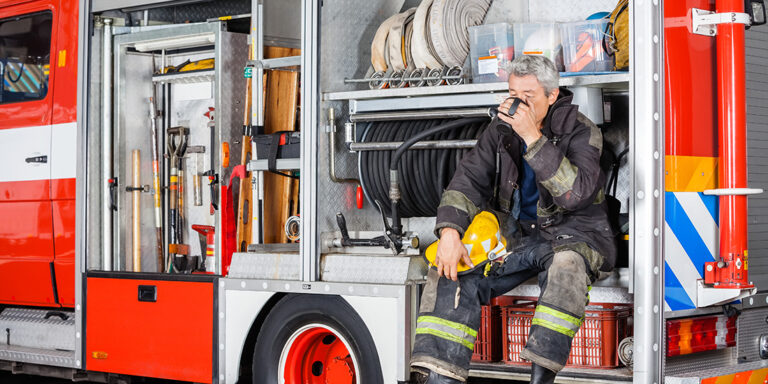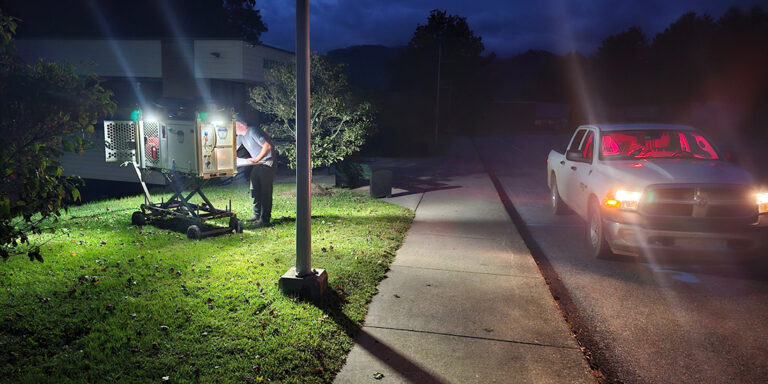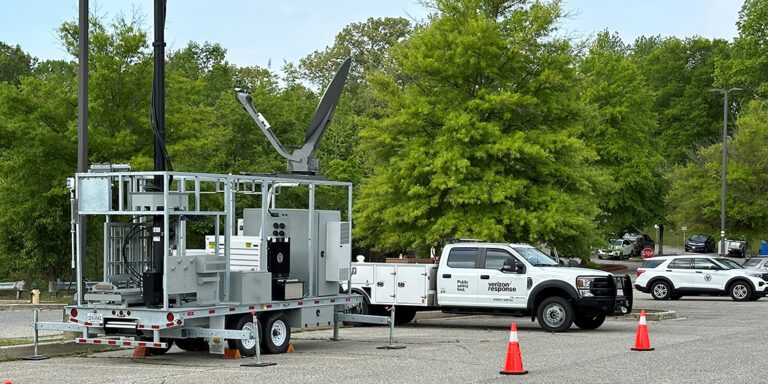
Article Archive by Year

Disasters affect responders and community members, but they also bring trauma to those working inside emergency operations centers. Distance from the scene does not create a shield from stress. Secondary traumatic stress can impair leadership, so managing this stress is vital for effective emergency response.

A Holistic Strategy for Responders’ Well-Being
May 7, 2025
First responders and emergency managers face constant, high-pressure stress from trauma, long hours, and critical decisions. This often leads to chronic stress, increasing risks of heart disease, mental health issues, and substance abuse. Their ability to help others depends on prioritizing their own well-being through proactive self-care.

Bridging Communication Gaps: Lessons from Hurricane Helene
April 30, 2025
Hurricanes in 2024 caused widespread damage to infrastructure, leading to a critical but often overlooked issue: isolation. Physical and technological disruptions left public safety personnel and government officials unable to perform essential tasks. While physical destruction was visible, the invisible breakdown of communication systems intensified the sense of isolation and

Connectivity: The Foundation of Disaster Response and Preparedness
April 30, 2025
In an era of increasingly frequent and severe weather events, the demands on first responders have never been greater. To navigate high-stakes, rapidly evolving situations, reliable connectivity and cutting-edge technology are essential. A fast, secure, and resilient communications network is the backbone of any effective disaster response.

Editor’s Note – Emergency Communications: Tough Lessons From the Maui Wildfires
April 30, 2025
The after-action report of the Maui wildfires and the authors in the April edition of the Domestic Preparedness Journal share valuable lessons for strengthening emergency communications in an ever-expanding complex communications ecosystem.

Emergency Alerts: The Missing Link
April 23, 2025
As satellite-to-cell technology grows more common, cell phone makers must move quickly to adopt it. This link can bridge emergency services and the public, no matter the disaster or condition of ground networks. Learn how real-time satellite communication saves lives by offering vital access for users and first responders.

Hidden Barriers to Public Safety Interoperability
April 23, 2025
Decades of work have improved public safety’s ability to share information. However, the journey toward better interoperable communication requires uncovering additional hidden barriers.

A Regional Approach to Public Safety Communications Planning
April 16, 2025
Despite significant investments in public safety, critical training gaps for first responders persist. Regional planning committees, established by the FCC in the 1980s to manage public safety radio frequencies, remain key to improving interoperability. Learn about ongoing efforts—both regional and national—to close communication gaps and improve coordinated emergency response.

A Systems Thinking Approach to Improving Emergency Communications
April 16, 2025
“PACE” planning helps organizations fail gracefully, but systems thinking reduces the likelihood of failure altogether. Combining both approaches helps organizations build resilience, regardless of threat or hazard.

Know the Audience: Five Keys to Effective Communication
April 9, 2025
Effective communication starts with understanding your audience—who they are, what they know, why they’re listening, and what they need to hear. Learn how this awareness can help you deliver a message your audience will understand, connect with, and remember.
Disaster Stress Management in an Emergency Operations Center
May 7, 2025
Disasters affect responders and community members, but they also bring trauma to those working inside emergency operations centers. Distance from the scene does not create a shield from stress. Secondary traumatic stress can impair leadership, so managing this stress is vital for effective emergency response.
A Holistic Strategy for Responders’ Well-Being
May 7, 2025
First responders and emergency managers face constant, high-pressure stress from trauma, long hours, and critical decisions. This often leads to chronic stress, increasing risks of heart disease, mental health issues, and substance abuse. Their ability to help others depends on prioritizing their own well-being through proactive self-care.
Bridging Communication Gaps: Lessons from Hurricane Helene
April 30, 2025
Hurricanes in 2024 caused widespread damage to infrastructure, leading to a critical but often overlooked issue: isolation. Physical and technological disruptions left public safety personnel and government officials unable to perform essential tasks. While physical destruction was visible, the invisible breakdown of communication systems intensified the sense of isolation and
Connectivity: The Foundation of Disaster Response and Preparedness
April 30, 2025
In an era of increasingly frequent and severe weather events, the demands on first responders have never been greater. To navigate high-stakes, rapidly evolving situations, reliable connectivity and cutting-edge technology are essential. A fast, secure, and resilient communications network is the backbone of any effective disaster response.
Editor’s Note – Emergency Communications: Tough Lessons From the Maui Wildfires
April 30, 2025
The after-action report of the Maui wildfires and the authors in the April edition of the Domestic Preparedness Journal share valuable lessons for strengthening emergency communications in an ever-expanding complex communications ecosystem.
Emergency Alerts: The Missing Link
April 23, 2025
As satellite-to-cell technology grows more common, cell phone makers must move quickly to adopt it. This link can bridge emergency services and the public, no matter the disaster or condition of ground networks. Learn how real-time satellite communication saves lives by offering vital access for users and first responders.
Hidden Barriers to Public Safety Interoperability
April 23, 2025
Decades of work have improved public safety’s ability to share information. However, the journey toward better interoperable communication requires uncovering additional hidden barriers.
A Regional Approach to Public Safety Communications Planning
April 16, 2025
Despite significant investments in public safety, critical training gaps for first responders persist. Regional planning committees, established by the FCC in the 1980s to manage public safety radio frequencies, remain key to improving interoperability. Learn about ongoing efforts—both regional and national—to close communication gaps and improve coordinated emergency response.
A Systems Thinking Approach to Improving Emergency Communications
April 16, 2025
“PACE” planning helps organizations fail gracefully, but systems thinking reduces the likelihood of failure altogether. Combining both approaches helps organizations build resilience, regardless of threat or hazard.
Know the Audience: Five Keys to Effective Communication
April 9, 2025
Effective communication starts with understanding your audience—who they are, what they know, why they’re listening, and what they need to hear. Learn how this awareness can help you deliver a message your audience will understand, connect with, and remember.
Follow Us
Get Instant Access
Subscribe today to Domestic Preparedness and get real-world insights for safer communities.
ARchives
Article Out Loud – A Holistic Strategy for Responders’ Well-Being
May 7, 2025
This is an article by Camilo Olivieri, an Article Out Loud from Domestic Preparedness, May 7, 2025. First responders and emergency managers face constant, high-pressure stress from trauma, long hours, and critical decisions. This often leads to chronic stress, increasing risks of heart disease, mental health issues, and substance abuse.
Article Out Loud – Bridging Communication Gaps: Lessons from Hurricane Helene
April 30, 2025
This is an article by Greg Hauser, an Article Out Loud from Domestic Preparedness, April 30, 2025. Hurricanes in 2024 caused widespread damage to infrastructure, leading to a critical but often overlooked issue: isolation. Physical and technological disruptions left public safety personnel and government officials unable to perform essential tasks.
Article Out Loud – Connectivity: The Foundation of Disaster Response and Preparedness
April 30, 2025
This is an article by Rodrigo (Roddy) Moscoso, an Article Out Loud from Domestic Preparedness, April 23, 2025. As satellite-to-cell tech grows more common, cell phone makers must move quickly to adopt it. This link can bridge emergency services and the public, no matter the disaster or condition of ground
Article Out Loud – Emergency Alerts: The Missing Link
April 23, 2025
This is an article by Rodrigo (Roddy) Moscoso, an Article Out Loud from Domestic Preparedness, April 23, 2025. As satellite-to-cell tech grows more common, cell phone makers must move quickly to adopt it. This link can bridge emergency services and the public, no matter the disaster or condition of ground
Article Out Loud – Hidden Barriers to Public Safety Interoperability
April 23, 2025
This is an article by Gabe Elias, an Article Out Loud from Domestic Preparedness, April 23, 2025. Decades of work have improved public safety’s ability to share information. However, the journey toward better interoperable communication requires uncovering additional hidden barriers. Learn how to examine response operating procedures to uncover those
Article Out Loud – A Regional Approach to Public Safety Communications Planning
April 16, 2025
This is an article by Charles (Charley) Bryson, an Article Out Loud from Domestic Preparedness, April 16, 2025. Despite significant investments in public safety, critical training gaps for first responders persist. Regional planning committees, established by the FCC in the 1980s to manage public safety radio frequencies, remain key to
Article Out Loud – A Systems Thinking Approach to Improving Emergency Communications
April 16, 2025
This is an article by William Chapman, an Article Out Loud from Domestic Preparedness, April 16, 2025. “PACE” planning helps organizations fail gracefully, but systems thinking reduces the likelihood of failure altogether. Learn how combining both approaches helps organizations build resilience, regardless of threat or hazard.
Article Out Loud – Know the Audience: Five Keys to Effective Communication
April 9, 2025
This is an article by Marc Hill, an Article Out Loud from Domestic Preparedness, April 9, 2025. Effective communication starts with understanding your audience—who they are, what they know, why they’re listening, and what they need to hear. Learn how this awareness can help you deliver a message your audience
Article Out Loud – AI Software in 911 Dispatch Centers: An Innovative Solution
April 2, 2025
This is an article by Tanya Scherr, an Article Out Loud from Domestic Preparedness, April 2, 2025. Coupled with continued staffing challenges, mental health and work-life balance difficulties in emergency call centers are cause for concern. Learn how AI can take some of the burden from existing staff and leadership,
Article Out Loud – Agriculture Security: Systems-Based Preparedness
March 26, 2025
This is an article by Joshua Dise and Adrian Self, an Article Out Loud from Domestic Preparedness, March 26, 2025. As economies and populations grow, food and agricultural security is of increasing concern. Learn how proactive investment in risk management and security measures can ensure the sustainability of the global
Follow Us
Get Instant Access
Subscribe today to Domestic Preparedness and get real-world insights for safer communities.


